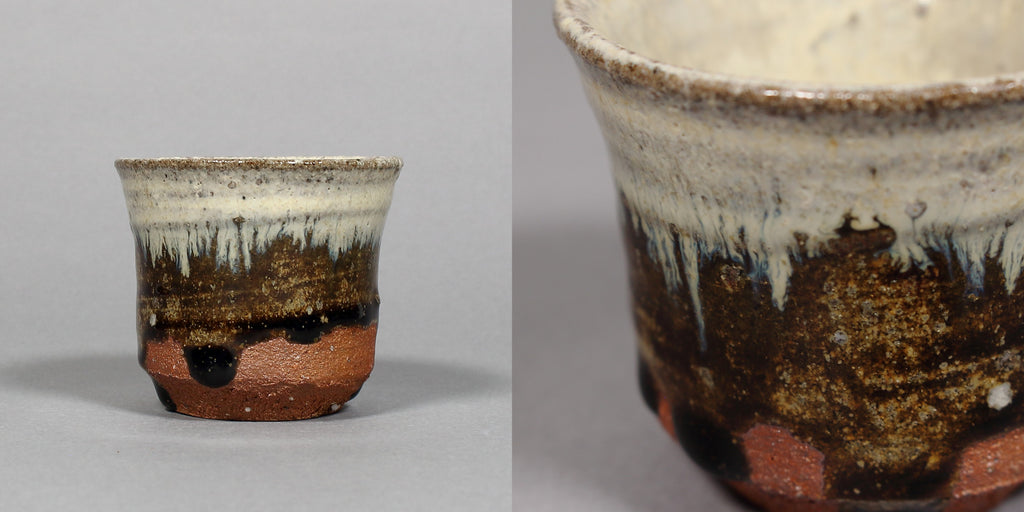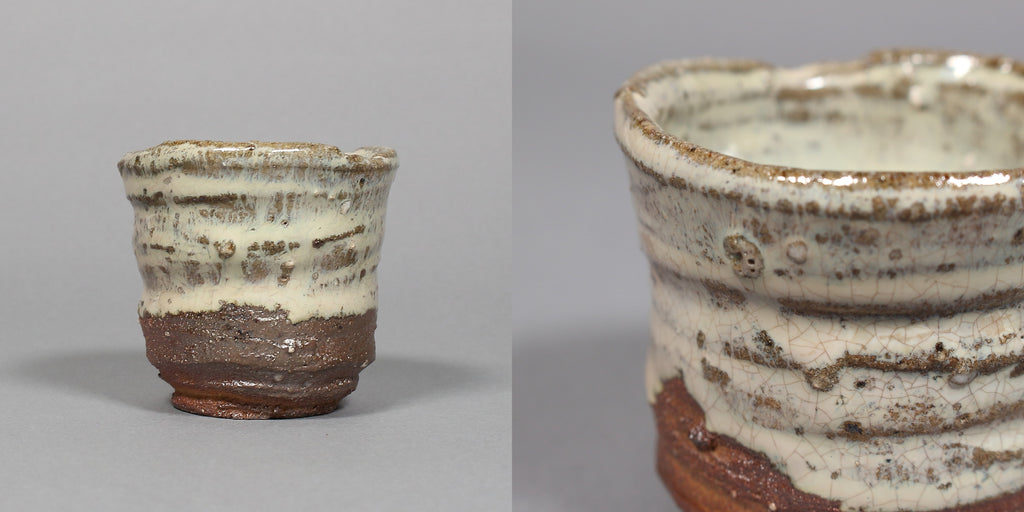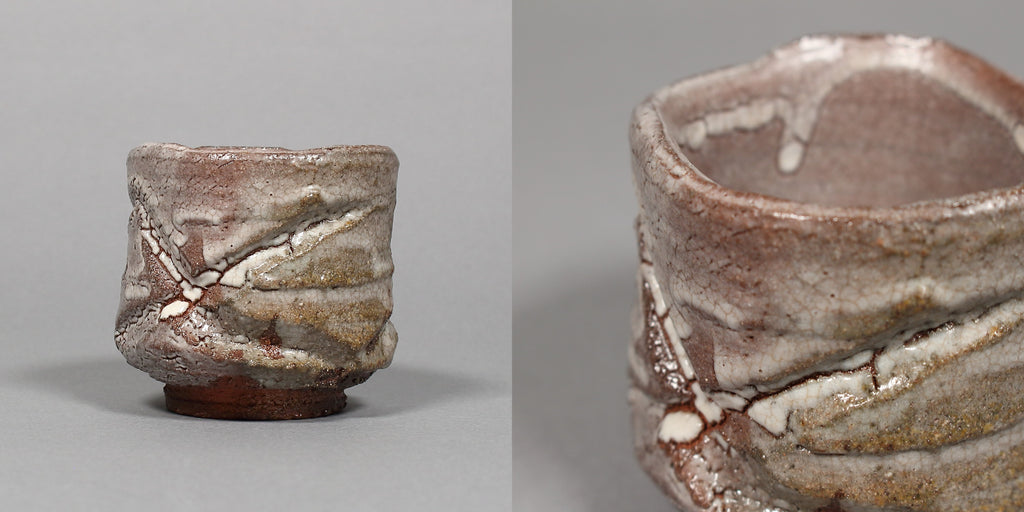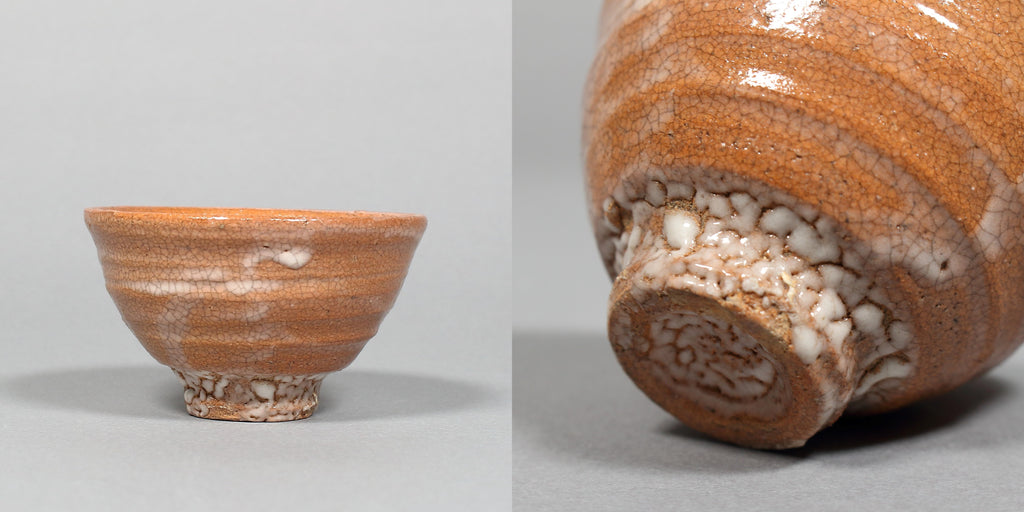In spring, many sake breweries open their doors and sell spring-only sake, ``Harusake(Spring sake).'' Many sakes have a subtle sweetness, a refreshing taste, and a gorgeous aroma, and they pair best with seasonal ingredients such as bamboo shoots and wild vegetables. In order to enjoy such ``spring sake'' even more, you should be particular about choosing sake vessels. Continuing from the other day, we have now received 17 new sake cups, ``Guinomi,'' by Karatsu ware artist Naoki Kojima, so we would like to introduce them to you and tell you about the charm of ``Guinomi.''
Difference between “guinomi” and “ochoko”
Typical sake vessels are the ``Guinomi'' and the ``Ochoko''. The origin of the word ``Guinomi'' is that it was a container that could hold an amount of alcohol that could not be finished in one gulp, and the name ``Guinomi'' came to be from the fact that the sake could be enjoyed in one go. ``Ochoko'' comes from the word ``a small thing,'' and in contrast to ``Guinomi,'' it is a container that holds the amount of alcohol that can be drunk in one sip.
*For details, please see here: #04| Differences between Ochoko, Guinomi, and Sakasuki
By the way, the history of "Guinomi" is old and is said to date back to the late Azuchi-Momoyama period. It is said to have its origins in the ancient times when, after enjoying the food served on mukozuke, a utensil used in kaiseki cuisine, sake was poured into the empty mukozuke.
The charm of Karatsu ware “Guinomi”
Its biggest appeal is its unique texture and clay. This is because the Karatsu clay, which is the raw material, contains a lot of sandstone, which is also the raw material for glass, and when fired at high temperatures, the glass components melt and harden, creating a rough, earthy flavor. Karatsu ware also uses traditional techniques and glazes, and one of its charms is that it can be made in a variety of expressive ``Guinomi''.
Karatsu ware decoration techniques you need to know
Karatsu ware has various decorative techniques. We will introduce techniques and traditional glazes that have been passed down since ancient times, along with Naoki Kojima's new work, ``Guinomi''.
“Korean Karatsu” uses two types of glazes: candy glaze and straw ash glaze, and the highlight is how the glazes naturally blend together when fired at high temperatures. . This is a very difficult technique, and it is common to apply a black iron glaze on the bottom and pour a milky gray glaze on top. The beautiful contrast between black and white is attractive, and you can also enjoy the scenery with the glossy tamari, the "bleeding" of the parts that blend together, and the blue and yellow colors that appear at the boundaries.
Madara Karatsu is called Madara Karatsu because it is fired with a cloudy straw ash glaze and its surface becomes mottled. Many of the mottled patterns are caused by the iron content of the base material being fired, and serve as accents. Madara Karatsu is characterized by its milky white glaze and clay unique to Karatsu. The real appeal is the crunchy texture of the clay that is not glazed. Also, when you pour alcohol into it, the milky white color shakes and shines, making the sake even more delicious.
Karatsu ware ``E-Karatsu'' is said to be the first painted vessel in Japan, and is painted with iron pigment called Oniita on the base material, and is coated with feldspar glaze (transparent glaze). ) and baked. It is a technique representative of Karatsu ware, and is used for a variety of vessels. The motifs depicted are diverse, including plants, flowers, birds, animals, and geometric patterns, and one of their charms is their free-spirited touch and strength.
``HoriKaratsu'' refers to the process of carving simple geometric patterns on the base material using a bamboo spatula or comb while it is still partially dry after being formed, then coating it with feldspar glaze or mottled glaze and firing it. The strong carving patterns and the kairagi inside the carvings are the highlights.
・Karatsu Ido sake cup *The highlight is the kairagi on the foot ring.
This cup is made from rare clay from the Kitahata district of Karatsu City, the birthplace of Karatsu ware. It is a beautiful masterpiece with a reddish-fired finish, kairagi on a foot ring, bamboo joint foot ring, fine cracks, and potter's wheel marks that can only be made by hand. “Kairagi” is created from the difference in shrinkage between soil and glaze, and refers to the state in which the glaze curls into particles. The name comes from the similar granular surface of a type of shark skin used for sword sheaths, which was originally called kairagi.
・Makara Karatsu kawakujira guinomi ※The highlight is the skin around the rim of the mouth.
The distinctive feature of Kawakujira is the black border around the rim. The name Kawakujira comes from the fact that the black rim represents the skin of a whale (back), and the white of the vessel body represents the body of the whale (belly). This is a one-of-a-kind work of art, the fine Kan-nyu (Crackle), the shell marks on a foot ring that can only be achieved by hand, Tokin, and clay unique to Karatsu ware.
This is a masterpiece that allows you to feel the aesthetic sense of "wabi-sabi" that is unique to Japanese culture. It is made from rare soil from the Kitahata district of Karatsu City, the birthplace of Karatsu ware, and has beautiful fine intrusions, Tokin, shavings, and clay unique to Karatsu ware. The expression of the clay that can be glimpsed through the gaps in the glaze has a chance that cannot be reproduced, and you will never get tired of looking at it. The tasteful colors left to nature are also one of its charms.
Just as we enjoy dishes made with seasonal ingredients, there are different ways to enjoy sake depending on the season. In spring, when the plants are budding, why not enjoy the gorgeous aroma of ``Spring Sake'' with your favorite sake?
*You can view Kojima's works, including the works introduced this time, here .
*If you are interested in the interview article with Mr. Kojima and the history of Karatsu ware, please also check here .
A series of stories about “Japanese ware” that makes you want to tell someone.
・#01|What is "Japanese tableware"?
・#02|What is the “KESHIKI” you have heard about?
・#03|What is the difference between pottery and porcelain?
・#04|Differences between Ochoko, Guinomi, and Sakazuki
・#05 | Kyushu, the Kingdom of Pottery
・#06|Dining table decorated with Karatsu ware








